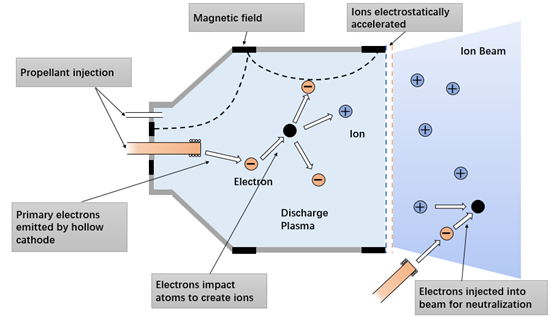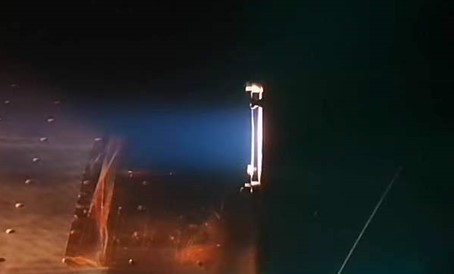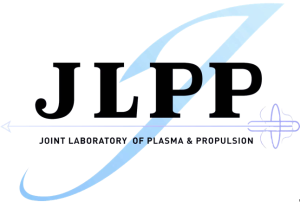Our research
Ion thruster
Ion thrusters are often used to refer to gridded electrostatic ion thrusters. Ion thruster (IT) is an electrostatic electric propulsion device in which the acceleration energy is almost entirely converted from the potential energy of the electric field. Ion thrusters employ a variety of plasma generation techniques to ionize a large fraction of the propellant. These thrusters then utilize biased grids to electrostatically extract ions from the plasma and accelerate them to high velocity at voltages up to and exceeding 10 kV.

Principle of the Ion thruster
Gridded electrostatic ion thruster development started in the 1960s. since then, it has been used for commercial satellite propulsion and scientific missions. Their main feature is that the propellant ionization process is physically separated from the ion acceleration process. (History)
Ion thrusters feature the high efficiency (from 60% to >80%) and very high specific impulse (from 2000 to over 10,000 s). Applications of ion thrusters include control of the orientation and position of orbiting satellites (some satellites have dozens of low-power ion thrusters) and use as a main propulsion engine for low-mass robotic space vehicles. (Applications)
The largest difference in the many ion thrusters is the method of ionizing the propellant atoms – electron bombardment (NSTAR, NEXT, T5, T6), radiofrequency (rf) excitation (RIT 10, RIT 22, µN-RIT), microwave excitation (µ10, µ20). Related to this is the need for a cathode and a required effort for the power supplies. Kaufman type engines require at the least, supplies to the cathode, anode and chamber. The rf and microwave types require an additional rf generator, but no anode or cathode supplies. (Variants)
In our laboratory, we have developed a miniature ion thruster using atom-electron bombardment ionization mode with a power of less than 50 W and a thrust of more than 1mN. This thruster uses permanent magnets and coils as the magnetic field source and introduces a double-anode structure which can effectively reduce the discharge power of the miniature ion thruster by adjusting the excitation current and thus improve the overall efficiency of the thruster.
In addition, we are also developing a new miniature helicon plasma source and working on the application of the helicon plasma source in combination with a gridded acceleration system.

Ion thruster on operation in our lab
(Lastly Updated in September, 2022)
